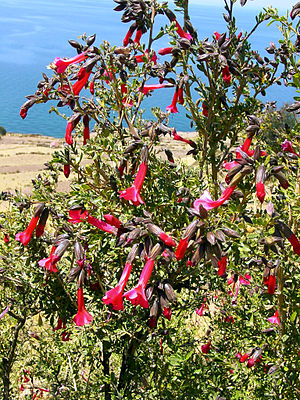Cantua buxifolia
| Cantua buxifolia | ||||||||||||
|---|---|---|---|---|---|---|---|---|---|---|---|---|

Cantua buxifolia on Taquile Island ( Peru ) in Lake Titicaca |
||||||||||||
| Systematics | ||||||||||||
|
||||||||||||
| Scientific name | ||||||||||||
| Cantua buxifolia | ||||||||||||
| Lam. |
Cantua buxifolia ( span. Cantuta , even kantuta or Qantuta , of Quechua qantu named) is a plant in the family of polemoniaceae (Polemoniaceae).
description
Vegetative characteristics
Cantua buxifolia grows as a shrub that reaches heights of between 2 and 3 meters. Their relatively small leaves are rough and lanceolate in shape.
Generative characteristics
The cantuta blooms all year round. Its flowers are odorless, with a short calyx and very showy colors, generally white , yellow , pink and intense red .
Occurrence
Cantua buxifolia grows wild or cultivated in the Andes zones of Bolivia and Peru , at altitudes between 1200 and 3800 meters. It thrives best on loose, clay-rich soil with organic components and good drainage .
Usage and symbolism
Cantua buxifolia was already cultivated in pre- Hispanic times and is also known under the Spanish names "La Flor Sagrada de los Incas" (directly translated "Sacred Flower of the Inca") or "Flor del Inca" (directly translated "Flower of the Inca"). It is the national flower of Peru and one of two national flowers of Bolivia , the other is Patujú ( Heliconia rostrata ). It can be propagated by seeds and cuttings. By crossing , varieties with a greater variety of flower colors were bred.
swell
- Antonio Díaz Villamil: Leyendas de mi tierra (Editorial América srl, La Paz); “The Complete Legend of the Tricolor Kantuta” (translation into French) [1]
Individual evidence
- ↑ Profile of the University of Bochum. ( Memento from July 16, 2007 in the Internet Archive )